Heather Rasmussen’s obsession with portrayals of disaster on film corresponds with the unwieldy region of her birth–the greater Los Angeles area—which has blown up, slid into the ocean, had its freeways rumpled by earthquakes, and provoked citizens’ uprisings across newsreels and fictional features more than most land masses of its size. Rasmussen grew up on the southern end of the sprawl, in the North Orange County city of Placentia. She has come of age in a time when aerial photography and global satellite surveillance have made it possible for cameras to capture the destruction of entire towns by big weather or war. (We can even see ships before they sink in previously un-surveilled parts of the ocean.) These cameras also allow images to be rapidly distributed and to increasingly catastro-phillic audiences. These last four years, Rasmussen has been photographing, to scale, paper models based on online images of shipping container disasters.
“I find something very beautiful in images of catastrophe, which is actually a pretty dark way of looking at things. I think it started out as being a naive attraction to disaster scenes, related to the overwhelming cluttered house that I grew up in.” Rasmussen’s mother is a compulsive hoarder. In 2003, Rasmussen abruptly quit her course of study in classical ballet to begin rigorously working in photography. She began by taking inventory of her childhood home, beginning with black and white studies of her mother’s living room.
Rasmussen moved on to do several collaborative archiving projects with her mother, shooting her collections of buttons, fabrics, and Santa dolls and tchotchkes one object at a time, and then arranging the prints into grids.
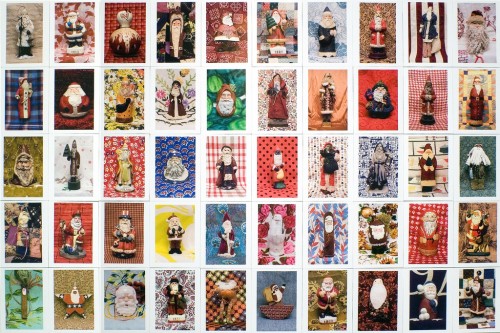
Heather Rasmussen. Installation shot from “Santas and Sailors,” 2006. Courtesy of Heather Rasmussen.
“With the [photos of] the house, the idea of choosing a particular group of things and organizing them through photographs was my way of trying to understand my mother. Why did she need all these things? I envisioned photographing each series of objects in the house and making a book of each one, so she could still have the object visually, but of course that would not solve her need to constantly buy, collect, and hoard. In a way, it is its own type of catastrophe preparedness—having everything you think you need all of the time, just in case in the future something happens. I tend to keep a bit of this feeling inside me—always having a large bag with everything I know I will need for the day; always having an emergency kit inside my car or house in preparation for the next big earthquake.”
In 2005, Rasmussen was studying at Cal Arts, living in Los Angeles, and making frequent drives from Santa Ana to Valencia along the 110 and 405 freeways to photograph intensely personal work. She was becoming exhausted. “I had to cut this off. I needed to figure out something else to do. I didn’t go looking for anything but I was between LA and where I would go in Orange County—I would drive the 110 to the 405—and you kind of see the Port of Los Angeles when you’re going north… This one night, I was just like, “What is that? I have all my camera gear on me, I’m going over there.” In her 2005 artist book “fifth visit three daytime two nighttime first time alone, night time,” Rasmussen printed these photos in postcard size, making a brief travelogue about her experience—the thrill of trespassing alone at night on Terminal Island, fearing rape, death by heavy machinery or police arrest—and drawing parallels between the threat of violence to her own body and the aggressive reconstruction of land and water into manageable travel ways for massive commerce.
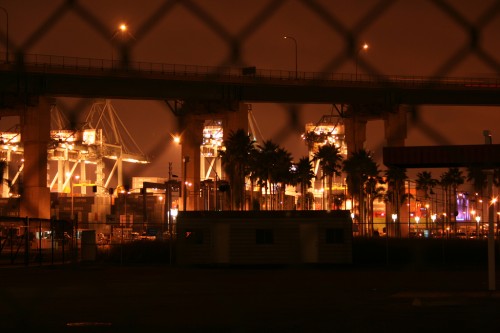
Heather Rasmussen. From “fifth visit three daytime two nighttime first time alone, night time,” 2005. Courtesy of Heather Rasmussen
Rasmussen became hooked on making these forays into the harbor. In the process she discovered that her grandfather volunteered on the WWII Lane Victory, a docked ship museum containing memorabilia collected by merchant marines. She helped to archive the objects in the collection with a 6×6 Bronica camera and exhibited them alongside her mother’s Santas. It was when she started to shift her eye from the ship to the harbor that she began the work that led her to make miniature studies of her own. “[When you look down at the harbor] Everything looks miniature. You can see everything and it’s peaceful, but when you’re down near the containers they’re overwhelming and huge and you feel small. And I figured out, I like the containers.”
She had a die cut to make hand-folded, seamless paper versions of views from certain sections of the pier. Initially, she set out to make a to scale sculpture of the pier called “The End Of The World,” but had to pare that back to a reconstruction of a tiny portion of the pier. When she surveyed a photo of the area in Google Maps, she realized how many thousands of containers were actually there. In the end, she amassed a body of work that contained over 4,000 paper replicas of shipping containers displayed alongside monumentally-sized prints of boom cranes.
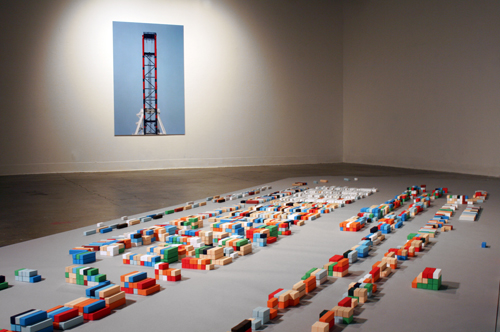
Heather Rasmussen. “Pier J (installation view from transporttransform”), 2007. Courtesy of Heather Rasmussen.
In recent years, Rasmussen has been systematically rearranging, altering, and destroying these model containers. In this, she is turning them into miniature abstract models of commercial wreckage; and moving toward exhibition arrangements that reveal something about her photographic set up.

Heather Rasmussen. “Untitled (Container Yard, Liverpool, UK, January 13, 2004),” 2012. Courtesy of Heather Rasmussen.
In 2012, a circumstantial house fire led Rasmussen to begin documenting ruins of a more personal nature. Drawing inspiration from John Divola as she took stock of what was left of her belongings, she shot formalist photos of doorways and things like a smoke-made shadow of a framed Polaroid.
In the process, Rasmussen rediscovered a besmirched cast of her own pointed foot, and began to make choreographed photographic sequences of her present self and this fragmented relic of her past as an aspiring ballet dancer. Through her use of repetition and scale distortion, Rasmussen has developed, in a sense, photographic memory in space, one that reflects her own vantage point and where the camera functions as a deliberately distorted mirror through which she plays with the illusion of containing much larger, unseen forces—internal, emotional and external, and natural. “I use scale to control the way the viewer interacts with each photograph. It’s a way to emphasize what is important to me, what I want you to look at, whether enlarging a smaller object to show details, or creating a miniaturized view of a massive world. It is a playful way to look at something but also confusing. And I like that it can make the viewer question what they are actually looking at as far as material and content and perhaps, even, how the image was made.”
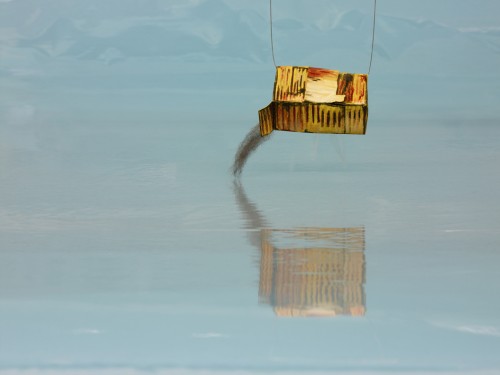
Heather Rasmussen. “Untitled (MV Rena, Astrolabe Reef, New Zealand, October 28, 2011),” 2012. Courtesy of Heather Rasmussen.
Rasmussen’s studio exists outside of her home, so none of her paper containers or artworks were destroyed in the fire. She has recently been using mylar and cellophane, and drawing in charcoal, on her paper containers. This she does to further confuse our sense of space and the processes that have brought about her most recent portrayals of shipping disasters. “It took me a few years to realize how my work with the Port of Los Angeles and shipping container disasters was also fulfilling my need to control scenes through images. I’m able to use the most precise type of camera, a 4×5, to make everything in the photograph sharp and in focus. The light I use is filtered and soft, leaving little or no shadow. This eerie but very technically formal setup adds another layer of my control on top of the catastrophe.”

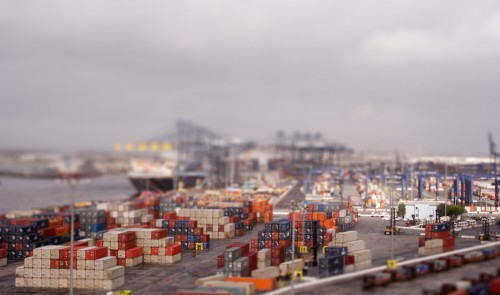
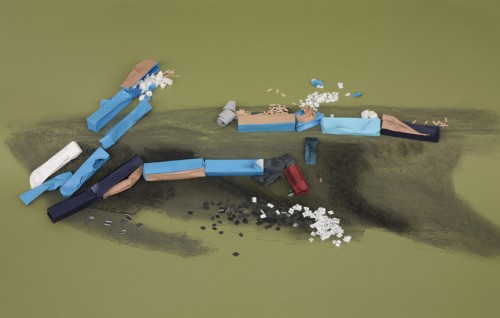
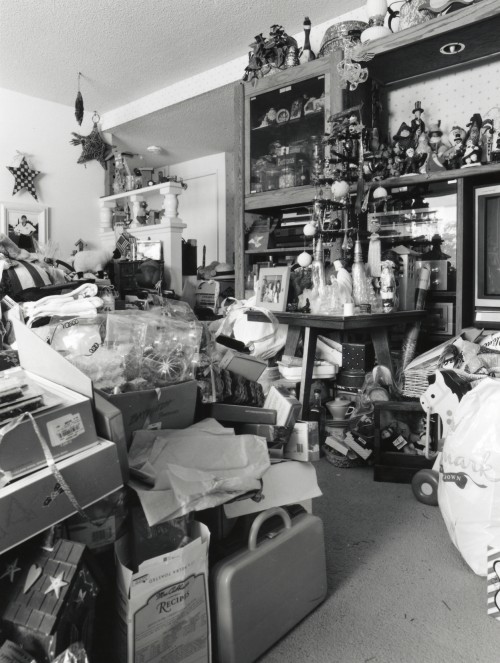

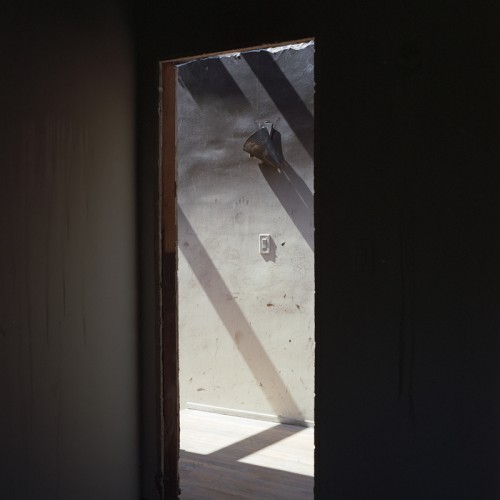





Pingback: Week in Review | Art21 Blog